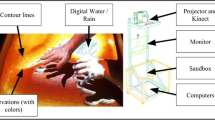Abstract
In this paper, we describe a framework for synchronous collaborative visualization and remote control in the agricultural domain. The framework builds on “Second Life” (SL), a popular networked online 3D virtual world, where users are represented as avatars (graphical self-representations). Co-presence in SL takes the form of instant (real-time) two-way interaction among two or more avatars. The aim of our work is to facilitate co-presence for sharing knowledge and exchanging wisdom about environmental practices. In order to establish a realistic simulated context for communication in SL, virtual counterparts of real devices are created in the virtual world. Specifically, we aim to represent field servers that sense and monitor fields such as rice paddies and vineyards. The Twin-World Mediator (TWM) is developed in order to replicate the behavior of real devices in virtual counterparts, and to facilitate seamless communication between real and virtual world. The TWM is an easy-to-use, extensible, and flexible communication framework. A small study demonstrated how the TWM can support collaboration and experience sharing in the agricultural domain.







Similar content being viewed by others
Notes
This was assessed by asking subjects to rate their expertise in agriculture in a seven-point Likert scale (1 representing “no knowledge at all” and 7 representing “professional knowledge”). The mean value for this was 3.6 (σ = 1.2).
References
Bainbridge WS (2007) The scientific research potential of virtual worlds. Science 317:472–476
Boellstorff T (2008) Coming of age in Second Life: an anthropologist explores the virtually human. Princeton University Press, Princeton, NJ
Boulos MNK, Hetherington L, Wheeler S (2007) Second life: an overview of the potential of 3D virtual worlds in medical and health education. Health Inform Libr J 24(4):233–245
Brandherm B, Ullrich S, Prendinger H (2008) Simulation of sensor-based tracking in second life. In: AAMAS ’08: proceedings of the 7th international joint conference on autonomous agents and multiagent systems, International Foundation for Autonomous Agents and Multiagent Systems, pp 1689–1690
Bray DA, Konsynski BR (2007) Virtual worlds: multi-disciplinary research opportunities. SIGMIS Database 38(4):17–25
Bryson S (1996) Virtual reality in scientific visualization. Commun ACM 39(5):62–71
Casanueva JS, Blake EH (2001) The effects of avatars on copresence in a collaborative virtual environment. Technical Report CS010200. Department of Computer Science, University of Cape Town, South Africa
Du K, Sun Z, Han H, Liu S (2008) Development of a web-based wireless telemonitoring system for agro-environment. In: International Federation for Information Processing (IFIP), Springer, Boston, pp 799–807
Eysenbach G (2008) Medicine 2.0: social networking, collaboration, participation, apomediation, and openness. J Med Internet Res 10(3):e22. http://www.jmir.org/2008/3/e22/
Fundinger A (2007) Real life control panel for Second Life. http://channel3b.wordpress.com/2007/01/24/real-life-control-panel-for-second-life
GlobalLab (2008–2009) GlobalLab project website. http://www.prendingerlab.net/globallab/
Ichikawa (2009) Yamani Orchard, Ichikawa. http://fsds.dc.affrc.go.jp/data4/Ichikawa01/
Kobayashi K (2009) Shinshu University’s field server. http://www.cs.shinshu-u.ac.jp/~kkobayashi/ja/index.php?fs-obuse
Leigh J, Johnson AE (1996) Supporting transcontinental collaborative work in persistent virtual environments. Comput Graphics Appl IEEE 16(4):47–51
libsecondlife (2007) libsecondlife project. http://www.libsecondlife.org
Lifton J, Feldmeier M, Ono Y, Lewis C, Paradiso JA (2007) A platform for ubiquitous sensor deployment in occupational and domestic environments. In: IPSN ’07: proceedings of the 6th international conference on information processing in sensor networks, ACM, New York, NY, pp 119–127
Lombard M, Ditton T (1997) At the heart of it all: the concept of presence. J Comput-Mediated Commun 3(2). http://jcmc.indiana.edu/vol3/issue2/lombard.html
Mangan J (1997) Participatory pest analysis. In: PLA notes, 28
Milgram P, Takemura H, Utsumi A, Kishino F (1994) Augmented reality: a class of displays on the reality–virtuality continuum. In: Proceedings of SPIE, vol 2351. Telemanipulator and Telepresence Technologies, Boston, pp 282–292
Ogi T, Tamagawa K, Yamada T, Hirose M (1999) Collaborative scientific visualization in networked immersive virtual environment. In: IEEE international conference on systems, man, and cybernetics (SMC ’99), pp VI-87–VI-91
OpenMetaverse (2009) Virtual worlds connection library. http://www.opensimulator.com/projects/libopenmetaverse
OpenSimulator (2009) Virtual worlds server technology. http://opensimulator.org
SensorML (2009) Sensor model language. http://www.opengeospatial.org/standards/sensorml
Valin S, Francu A, Trefftz H, Marsic I (2001) Sharing viewpoints in collaborative virtual environments. In: Proceedings of the 34th annual Hawaii international conference on system sciences
von Kapri A, Ullrich S, Brandherm B, Prendinger H (2009) Global lab: an interaction, simulation, and experimentation platform based on “Second Life” and “OpenSimulator” (demo paper). In: Proceedings Pacific-Rim symposium on image and video technology (PSIVT ’09)
Weaver AC, Morrison BB (2008) Social networking. Computer 41(2):97–100
Weber A, Rufer-Bach K, Platel R (2007) Creating your world: the official guide to advanced content creation for second life. Wiley, Indianapolis
Zhao S (2003) Toward a taxonomy of copresence. Presence: Teleoper Virtual Environ 12(5):445–455
Acknowledgments
This research was partly supported by a “Grand Challenge” Grant from NII, Tokyo. We would like to thank Kazuki Kobayashi and Yasunori Saito from Shinshu University and the NARC research group for their kind support.
Author information
Authors and Affiliations
Corresponding author
Additional information
S. Attasiriluk, A. Nakasone, W. Hantanong contributed equally to the content of the paper.
S. Attasiriluk and W. Hantanong were awarded a Memorandum of Understanding (MOU) Internship grant from the National Institute of Informatics, Tokyo.
Rights and permissions
About this article
Cite this article
Attasiriluk, S., Nakasone, A., Hantanong, W. et al. Co-presence, collaboration, and control in environmental studies. Virtual Reality 13, 195–204 (2009). https://doi.org/10.1007/s10055-009-0130-5
Received:
Accepted:
Published:
Issue Date:
DOI: https://doi.org/10.1007/s10055-009-0130-5




